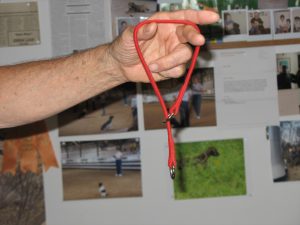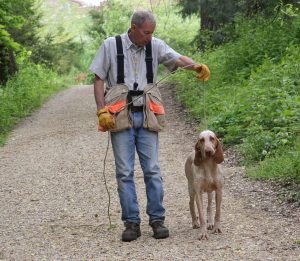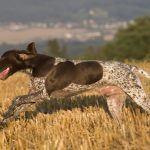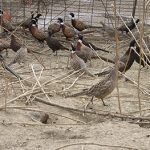Pointing Dog Pointers: Puppies and Yard Work
Pointing Dog Pointers
by Bob and Jody Iler
Yard work” is our bird dog term for obedience training! And when we talk about yard work, we primarily refer to three main commands: heel, whoa, and here (come). In formal obedience training, the commands of sit, down, stand, stay, and finish are added to the commands of heel and come (also known as the recall). In yard work, the whoa command would be comparable to the stand-stay obedience exercise, and the heel and here (come) exercises are basically the same.
Why do we only teach three commands to our young pups? In last month’s column we noted that we want our young pointing dog pups to develop their innate fire and enthusiasm for birds and hunting before we start putting control into them.
When we do begin yard work, we refrain from teaching the sit and down commands. It has been our experience that sometimes pups that have had these commands instilled in them may sit or lie down on point if any pressure is put on them. In fact, very few of our personal bird dogs have ever learned the command to sit! You may never have this problem with your pup, but this is how we do it, and is well worth the consideration.
It’s also worth noting that we know folks who have trained their pups in obedience and not had any problems in developing them as bird dogs. Generally speaking, though, these pups are bold and not intimidated by training. Because we’ve handled a multitude of clients’ dogs over the years, we never want to diminish any young pup’s drive by “putting the cart before the horse,” so to speak. We’ll never ruin a young bird dog pup by developing them our way, and we can add the yard work when the pup lets us know that he’s ready!
And how does the pup let us know that he’s ready?
Got kids? When they start to become unruly, don’t listen to you, and try to go their own way, you know it’s time to exert your God-given parental rights. Same with the bird dog pups! Now that we’ve got our young pointing dog student pulling us enthusiastically to the field, and anywhere else we try to go with him, we know it’s time to teach him to heel, to whoa, and to come when called (here!).
For yard work training, we’ve used the long checkcord version of the Delmar Smith lead, made of tough nylon with a loop at one end that goes around the dog’s neck and tightens or loosens, like a nylon slip collar. You can also use a regular checkcord, about 15-20 feet in length, attached to a nylon slip collar. We don’t favor choke chain collars as the links can get hung up and not release properly. Don’t use a flat collar and checkcord because your training won’t be effective!
The here command is best taught while your pup is on a long checkcord, busily investigating other things and paying no attention to you. You’ll want to work in an area where you can walk a good distance forward and let pup become preoccupied and nearing the end of the checkcord, giving it a little tension.
At the very moment that you give the command, “Here!” you’ll pop the checkcord with a snap and start backing up, encouraging pup to come to you. If he veers off, snap the cord again while commanding “here” at the same instant. You don’t want to drag or reel pup in like a fish; you want a snappy, no-nonsense here command while demonstrating (and enforcing) the command with the timely pop of the checkcord. Clapping your hands, offering praise, and even a treat, are all fine at first, to help pup understand what you want and make it a positive experience. Coming to you, whether he wants to or not, should always be a happy experience. Never call your dog to you to reprimand him.
After a few sessions of practicing the here command, your pup will start to get wise to the fact that when he ranges out, you’re going to pop the checkcord while commanding “here.” He’ll naturally start to stay closer to you, being more watchful of what you might do next. You may even need to be a bit creative to catch him off guard and give the here command. Try different areas and situations to distract him and teach him that here means come—right now and right to you—no matter where the two of you may be. This is the most important command you can teach your pup, and one that may prove to save his life someday.
During each training session, you’ll start with the here exercise, giving your dog a chance to range around, get the edge off, and acclimate to the “training mode.” It should only take a few repetitions and successful completions for your dog to start hanging around closer to you and paying attention to where you are going.
Now, it’s as natural as can be to gather up the checkcord and start walking briskly forward in a straight line. Keeping your pup on your left side, hold several feet of the checkcord in your left hand, and feed the rest loosely through your right hand, letting most of it drag behind you on your right. Your pup will pick up his pace and begin to trot along with you. As he gets closer to your side, gather the excess checkcord and praise him for walking with you. As you walk straight ahead with your pup at your left side, make a gradual about turn to your right and walk quickly in the opposite direction. If pup turns with you, pat your thigh, saying “heel” while encouraging and praising him.
If, however, pup forges ahead as you make your about turn, pop the checkcord as you turn while commanding “heel” at the same time. Walk a good distance in the new direction, then make another about turn (always to the right at first, because the pup will learn more easily this way). If pup forges ahead while you walk forward together, make an about turn in the opposite direction, repeating the instructions above.
Your goal is not to try to forcefully keep pup by your side with the checkcord, but to let him learn to naturally follow your lead. It’s less confusing and more effective at first to work this exercise in straight lines varied by the right about turns. As your pup improves and understands what you want, you can gradually start to work in long rectangle formations, still making your turns to the right. Always walk briskly so pup has no time to sniff, loiter or think about other things.
With only a checkcord and using a natural progression of exercises done each day for short, positive sessions, you’ve now taught your pup to come when called and to walk at heel by your side almost effortlessly. The next exercise, whoa, will also be taught in the same easy manner.
In formal obedience training, a dog that is heeling is taught to sit at heel when his handler stops walking. In our yard work program, you’ll introduce the whoa command as you slow to a halt during your heeling exercise. Normally walking briskly, you’ll slow down a bit, giving your pup a clue that something new is coming. As you slow and then stop, you’ll move your hand down the checkcord to about a foot above the pup’s neck and very quietly and gently, say “whoa.”
Pup will likely look up at you, wondering what’s going on. Start heeling again, doing your about turns and usual routine. Slow, then stop again, quietly commanding whoa while holding the checkcord taut. Let pup stand for just an instant, then start heeling with him again. In these early lessons of whoa, refrain from bending to pet or praise pup, because he’ll likely jump up, sit down, wriggle around, or otherwise move out of the whoa position, and right now, you’re just trying to show him what whoa means.
If pup wants to sit down or move about as you stop and command “whoa,” just continue moving and try the exercise again. Or, as you slow and stop, transfer the checkcord to your right hand and while holding the checkcord about a foot above the pup’s neck, slide your left hand under his flank closest to your side, preventing him from sitting. While keeping him in this standing position, gently repeat whoa, and then move on again in the heel exercise.
Teaching the whoa command to puppies in this manner is a wonderful way to introduce this exercise naturally and easily. Trying to place a young pup on a barrel or narrow plank, or using a “whoa stake” to teach him to stand still are exercises intended for older, bold pups as more of a polish to what has already been learned. The way we teach the whoa can be done anywhere, anytime, with only the use of your checkcord and training collar.
Young pups, like children, don’t like to be still for too long, so be patient in teaching this exercise. Like the here and heel commands, it will be useful not only in the field, but also as a means of control when you want your pup to be safe, as when you open his crate door in the back of a pickup truck on a hunting trip, or need him to stop instantly to be out of harm’s way.
Keep your sessions short, positive and consistent. Practice yard work at least once a day and as your pup improves, try different training areas to test him. Like kids, pups will need time to mature, so keep your sense of humor and patience and all will go well!
Pointing Dog Pointers features monthly training tips by Bob and Jody Iler, who own Green Valley Kennels in Dubuque, Iowa. Bob and Jody have trained pointing dogs for over 35 years and have written many articles for The Pointing Dog Journal.









